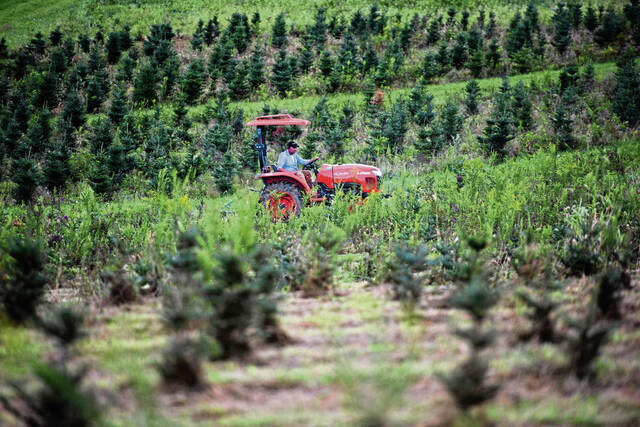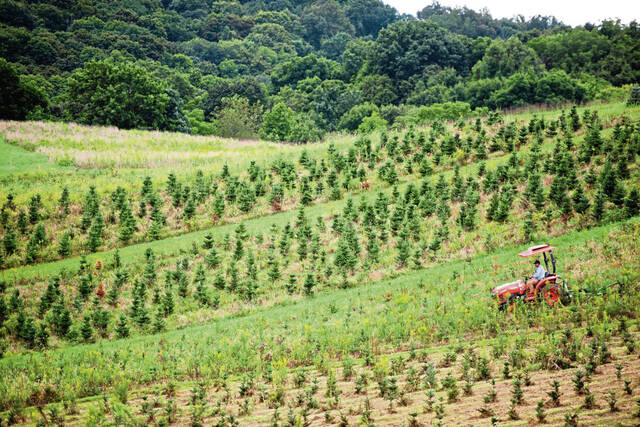Local retailers concerned about 2022 Christmas tree stock
The fall football season is barely underway and the holiday season is still just a twinkle in Santa’s eye, but for Christmas tree growers and sellers of cut trees, it’s crunch time.
And things aren’t looking so great.
For someone like Lou Biesuz of Export, who operates an annual Christmas tree lot, the past two years have him concerned about 2022.
“In the Christmas of ’20, all the lots were out of trees three weeks before Christmas, so the suppliers ended up getting second orders and selling a lot of their ’21 trees,” Biesuz said. “We thought ’21 would be better, but it ended up being worse — suppliers didn’t have a ton of (mature) trees left, and a bunch of them doubled their prices.”
Biesuz said his calls this year inquiring about “No. 1 trees” — “The nicest trees that get cut, about 10% of the total,” he said — are not bearing fruit.
“I’m being told that all their good trees were sold in ’20, and most of their other, smaller trees sold in ’21,” he said.
At Fleming’s Farms in Indiana County (“America’s Christmas Tree Capital”), Preston Fleming grows trees on seven properties, a combination of land he owns and leases.
“If you’re a retailer, like a farm market or fire company looking to bring in trees that are pre-cut, there’s definitely limited supply,” said Fleming, 35. “My cousins used to cut 60,000 trees a year, and there used to be 200-some growers in Indiana County at one time.”
Today, the retail and wholesale vendors listed on the Indiana County Christmas Tree Growers’ Association website number about 20.
Fleming said he usually buys his young trees when they are about three years old.
“There’s not many guys planting trees anymore,” he said. “It’s a long-term investment. I put $22,000 in the ground this spring, and I’ll wait a decade to get a return on it.”
It also means that tree farmers have to predict what the market will be a full decade ahead of time. That’s a near-impossibility according to Beth Bossio, who operates Quarter Pine Tree Farm, a choose-and-cut retail operation in Smithfield with a wholesale farm in Bruceton Mills, W.Va.
Bossio, 38, said part of the reason the cut-tree supply is so tight is more families have made the switch from artificial to real trees.
“They’re loving that experience, creating those memories,” Bossio said. “What I’m seeing is that a lot of farmers like us who used to have extra trees are cutting back and not selling as much to lots, because our choose-and-cut farm is huge. And we can make more money at that choose-and-cut price point.”
Boost in demand
Most people would probably like to forget about Christmas 2020; yet, on some level, that’s when the latest strain on live trees began.
It was the first Christmas of the covid-19 pandemic, and many families were staying home or hosting much smaller holiday gatherings than usual.
For the Christmas-tree industry, while that meant strong sales, it didn’t necessarily translate to a large increase in sales volume, according to the National Christmas Tree Association.
“A lot of consumers wanted to get a real tree for their Christmas celebration, and they wanted to shop early, resulting in many tree farms and seasonal lots opening the weekend before Thanksgiving,” NCTA officials wrote in their 2020 season overview. “This combination gave the impression that a surge in demand for real Christmas trees was occurring.
“However, the reality was, the tight supply of trees that were mature enough to be sold in 2020 was a real constraint. That tight supply capped the notion of a big leap in sales numbers.”
It was a pattern that repeated itself in 2021 — the Omicron variant caused covid-19 infections to climb again between Thanksgiving and Christmas, keeping travel numbers much lower than normal across the country.
Frank Gribbin, marketing director at Plumline Nursery in Murrysville, said he was looking to start a cut-tree lot this season, but has had to change his strategy.
“We found out there are almost no cut trees available to sell, especially for first-time buyers,” Gribbin said. “So we’re going to do what we do best — sell live trees.”
Gribbin said Plumline plans to offer potted spruces and firs in 10- and 15-gallon containers.
“You can bring it indoors, use it for the holiday, and you can plant it when you’re done so you’re not killing a tree either,” he said.
Bossio said freight costs are another big factor in what tree farmers are financially able to do.
“Most farmers want to sell by the truckload — one driver, one destination,” she said. “And if a lot only wants 50 trees, that’s not a truckload. And the freight cost just isn’t feasible in a lot of cases. If you can’t buy a truckload, it’s going to be kind of hard for a tree lot.”
Both Fleming and Bossio said their peers in the industry are numbering fewer and fewer.
“A lot of people who’ve come to us as new customers said the places they’ve gone the past 15 years are closed,” Bossio said. “And that should be an alarming thing not just for Christmas trees, but for food. Most tree farmers are also farming other crops, and tree sales help keep them going during the holidays.”
Fleming agreed.
“A lot of growers started getting out of the industry beginning about a decade ago, and now you’re starting to see the effects of that,” he said.
Patrick Varine is a TribLive reporter covering Delmont, Export and Murrysville. He is a Western Pennsylvania native and joined the Trib in 2010 after working as a reporter and editor with the former Dover Post Co. in Delaware. He can be reached at pvarine@triblive.com.
Remove the ads from your TribLIVE reading experience but still support the journalists who create the content with TribLIVE Ad-Free.



